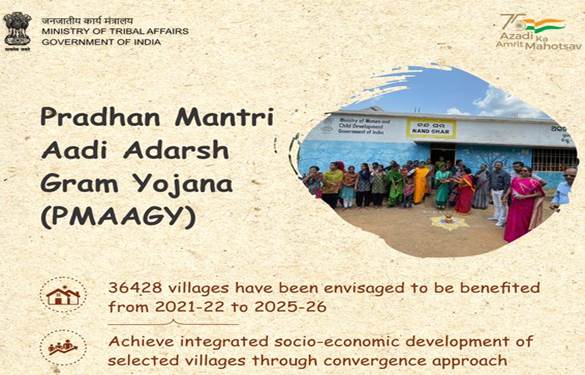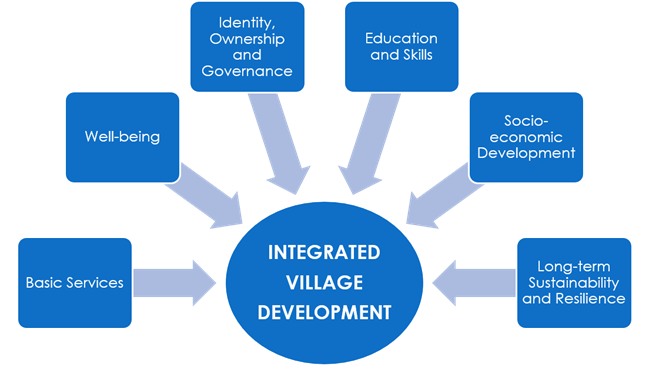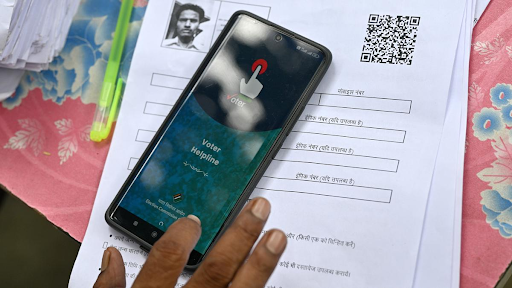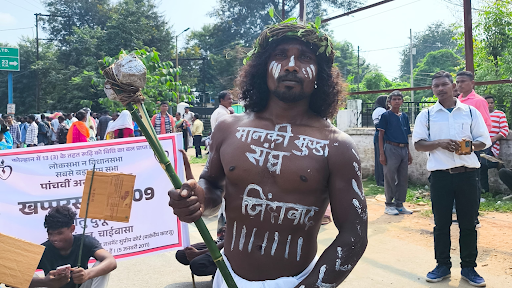Description

Copyright infringement not intended
In News
- The Minister of State for Tribal Affairs informed the Lok Sabha that the Union Ministry of Tribal Affairs has modified and renamed the ‘Special Central Assistance to Tribal Sub-Scheme’ to ‘Pradhan Mantri Adi Adarsh Gram Yojna (PMAAGY)’.
- The scheme implementation during 2021-22 to 2025-26.
- The Union Cabinet has approved a total amount of Rs. 7,276 cr for the scheme in the next 5 years.
Pradhan Mantri Adi Adarsh Gram Yojna (PMAAGY)
- The scheme aims to mitigate gaps and provide basic infrastructure in villages with a notable tribal population.
- It will cover 36,428 villages that have at least 50% ST population.
- The Yojna aims at transforming villages with significant tribal populations into model villages (Adarsh Gram) covering about 40% of the total Tribal Population.
- It is expected to cover 36,428 villages having at least 50% tribal population and 500 STs across States / UTs with notified Scheduled Tribes (STs).
- The main objective of the scheme;
- To achieve integrated socio-economic development of selected villages through a convergence approach.
- Preparing Village Development Plan based on the needs, potential, and aspirations.
- Maximizing the coverage of individual/family benefit schemes of the Central / State Governments.
- Improving the infrastructure in vital sectors like health, education, connectivity and livelihood.
- To mitigate gaps mainly in 8 sectors; Road connectivity (Internal and Intervillage /block), Telecom connectivity (Mobile /internet), Schools, Anganwadi Centres, Health Sub-Centre, Drinking water facilities, Drainage and solid waste management.
- A sum of ₹20.38 lakh per village as ‘Gap-filling’ has been provided for approved activities including administrative expenses under PMAAGY.
- States/UTs are encouraged for convergence of resources as Central / State Scheduled Tribe Component (STC) funds and other financial resources available with them for saturation of gaps in the villages identified under PMAAGY.
.jpg)
Characteristics of Adarsh Gram or Model Village
- Vision: Adequate physical and institutional infrastructure, where the minimum needs of all sections of the society are fully met. These villages should be covered with all the facilities necessary for a dignified living.
- They should be connected to the nearest major road by an all-weather road. Access for all to safe drinking water on a sustainable basis.
- All houses should have electricity and adequate street lighting.
- A village should have adequate communication facilities, such as a post office, telephones, and, if possible, internet, and Common Service Centre.
- Availability of adequate banking facilities through regular branches in the village or close proximity, and the Business Correspondent/Business Facilitator Model.
- All residents should have adequate housing, and there should be no homeless families.
- The village should have a high degree of sanitation; it should be free from dry latrines, and open defecation, and should have sanitary toilets, drains and an efficient waste disposal system.
- The Village should take care of its environment through; Planting trees, Water harvesting and maintenance of water bodies, Use of renewable sources of energy, such as biogas, solar energy, wind energy, Use of smokeless chulhas, etc.
- The village should have adequate and attractive buildings for its Anganwadi, school, health centre, Panchayat, and community hall. The village should have adequate facilities for sports and other physical activities.
- All children in the age group of 3-6 should be enrolled in, and regularly attend the Anganwadi. Likewise, all children in the 6-14 age group should be enrolled in and regularly attend school.
- All adults should be at least functionally literate and should have access to facilities for continuing education.
- Access for all to primary health care and Reproductive Child Health (RCH) facilities, with proper prenatal and ante-natal care for mothers.
- 100% institutional deliveries, full immunisation of children, and observance of the small family norm.
- The village as a community should take special care of its women, children (especially girls), senior citizens, and persons with disabilities.
- There should be no public consumption of liquor or any other intoxicating substances, and their use, in general, should be discouraged.
- There should be no caste-based discrimination, complete eradication of untouchability, and a due sense of security and dignity among the weaker sections.
- Residents of the village should be aware of and exercise their constitutional and legal rights. Likewise, they should also be aware of and discharge their fundamental and civic duties.
- All youth and adults of the village should have adequate employment and means of livelihood, and there should be adequate arrangements for the development of skills among them so that as many of them as possible are in skilled employment.
- Progressive and efficient practices, based on new technology, should be used in all the economic activities pursued in the village, especially in agriculture, animal husbandry, fisheries etc.
- Should have adequate access to remunerative prices for agricultural and other products of the village.

Expected outcome
- It would ensure the integrated development of the selected villages into “model villages”.
- Improve the physical and social infrastructure for socio-economic development and villages, and satisfy the norms mentioned in the vision of an Adarsh gram.
- Eliminate the differences between SC and non-SC populations in terms of common socio-economic indicators (e.g. literacy rate, a completion rate of elementary education, IMR/MMR, ownership of productive assets, etc.).
- To ensure that all BPL families, especially those belonging to SCs, have food and livelihood security, and are enabled to cross the poverty line and earn an adequate livelihood.
- Provide adequate support to all children to complete at least eight years of education.
- Eliminate the Incidence of malnutrition, especially among children and women.
- Eliminate untouchability, discrimination, segregation, and atrocities against SCs, and also other social evils like discrimination against girls/women, alcoholism and substance (drugs) abuse, etc.,
- Empower all sections of society to live with dignity and equality, and in harmony with others.
.jpg)
Must Read: https://www.iasgyan.in/daily-current-affairs/tribal-development-report
https://www.iasgyan.in/infographics/tribes-of-india
https://www.pib.gov.in/PressReleasePage.aspx?PRID=1882862
https://t.me/+hJqMV1O0se03Njk9






.jpg)








